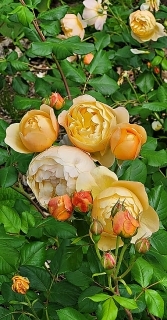Adam Yamey's Blog: YAMEY, page 11
June 22, 2025
Where there was wool there was wealth
HADLEIGH IS A SMALL town in Suffolk (England). Like many towns in East Anglia, it was enriched by the wool trade in mediaeval times. Evidence of this included magnificent, cathedral-like churches and fine civic buildings. Hadleigh is no exception. Its fifteenth century half-timbered market hall (now a part of the town’s guildhall complex) is on one side of a graveyard that separates it from the south side of the large, fifteenth century parish church.
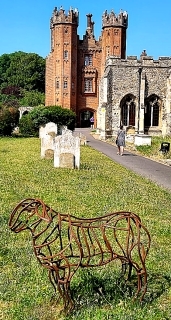
In one corner of graveyard there is a modern sculpture made of metal (mild steel). It depicts a sheep. Created by Benjamin Bramma, it was placed in the churchyard in 2015. That year, Hadleigh celebrated its rich heritage by holding a festival called “The Year of the Sheep”. As part of the festival, forty sheep were herded through the town.
The sculpture is a fitting tribute to the memory of the creatures that once brough wealth to Hadleigh.
June 21, 2025
An angel at a town in Suffolk
DURING THE EARLY 1960s, my parents used to take us to Cambridge, where one of my father’s friends, the late Cyril Sofer, lived with his family. Often, we spent the night before our meeting with the Sofers at Bury St Edmunds. We always slept at the town’s Angel Hotel that faces the park containing the ruins of the monastery attached to the still existing Abbey.
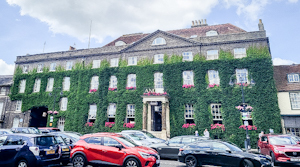 Angel at Bury St Edmunds
Angel at Bury St Edmunds This June (2025), my wife and I spent a little time in Bury St Edmunds. The Angel, whose facade is covered with foliage, is still in business. When I used to stay there many decades ago, the bedrooms were equipped with harnesses attached to ropes. These were to enable the occupants to escape from the room during a fire. I mentioned this to the receptionist during our visit in 2025. She had never heard of these fire escape aids, but then, I stayed at the hotel long before she was born.
While looking at the hotel’s facade, I noticed that the writer Charles Dickens had stayed there at least once. The town figures in “The Pickwick Papers”.
While walking in the park opposite the hotel, we came across a sculpture shaped like a teardrop. Placed in 2015, it is a memorial to all victims of genocide. It also records that 57 Jewish residents of Bury St Edmunds were massacred near the spot on Palm Sunday in 1190.
Brief as was our latest visit, Bury St Edmunds offers many interesting things for visitors to discover
June 19, 2025
Order and chaos portrayed in South London’s Peckham
THE ARTIST LEONARDO Drew was born in 1961 at Tallahassee, Florida (USA), and now works in Brooklyn (New York City). Until 7 September 2025, an entire, large room at the South London Gallery in Peckham is occupied by a work by Drew, which has the name “Ubiquity II”.
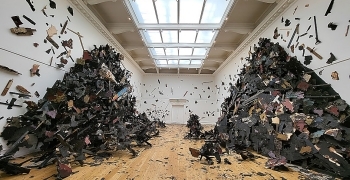
At first sight, the viewer is confronted by what looks like the chaotic result of a big explosion. The room is filled with fragments of wood, some of which is piled in heaps leaning against the walls, and the rest scattered on the floor, on which visitors tread. On closer examination, it can be seen that there are fragments of mirrors amongst the debris, and almost every piece of wood has paint or some other modification on it.
Despite looking like disorganised chaos, it is not. The artist carefully selected each of the fragments, modified them (often with paint), and then carefully arranged them to produce what the viewer sees. He has created the depiction of chaos and destruction in a most careful orderly way. As the gallery’s website put it, Drew:
“… creates reflective abstract pieces that play on the tension between order and chaos. Transforming and eroding materials by hand in the studio, he explores the cyclical nature of life and decay.”
And given what is happening in the world today, this powerful depiction of order and chaos is particularly relevant.
A famous architect
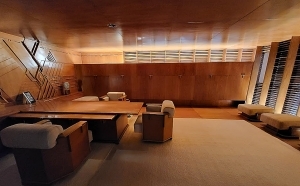 An office by Frank Lloyd wright
An office by Frank Lloyd wrightOh, Frank Lloyd Wright
Architect of great renown
Sadly exists no more
June 18, 2025
A warehouse filled with wonderful artefacts in east London
MANY MUSEUMS INCLUDING London’s Victoria and Albert (‘V&A’) own far more items than they have room to display them. The objects for which there is no gallery space to display them usually lie hidden away in museums’ storerooms. Following the example of a museum in Rotterdam, the Museum Boijmans Van Beuningen, the V&A has created an open access storeroom, where members of the public can see many of the objects that were formerly hidden away from view in the museum’s old warehouses.

V&A East Storehouse, which was designed by the American studio Diller Scofidio + Renfro, opened its doors to public visitors on 31 May 2025. It is in the Queen Elizabeth Olympic Park near East London’s Stratford Station and West Ham’s football stadium. We had to queue for about 20 minutes before gaining admittance on a sunny Sunday afternoon. It was well worth waiting to see this incredible creation.
The parts of the Storehouse which are open to the public are arranged on three floors. The upper two are on galleries that overlook the lowest floor. Stepping into this edifice is rather like entering a huge B&Q or Ikea warehouse filled with shelving. However, there the similarity ends. The shelves are covered with an amazing variety of artefacts, ranging from ancient to modern times, and sourced from all over the world. There is also a viewing platform that allows visitors to watch the museum’s conservators working. Another room houses only one exhibit: an enormous backdrop that Picasso painted for the 1924 performance of the ballet, “Le Train Bleu”. It measures 10.4 by 11 metres, and is the artist’s largest known painting.
Without going into much detail, it seems that whoever arranged the artefacts in the Storehouse had a great sense of humour. For example, a twentieth century chair is placed right next to a rococo chest of drawers, and a fragment from a mediaeval church is placed immediately above an early example of a television. Few of the artefacts are labelled apart from bearing their museum inventory numbers. Dotted around this contemporary Aladdin’s Cave of cultural treasures, there are several exhibits with labels that explain various aspects of running the V&A and its curatorial philosophy.
With good transport connections to central London, there is no excuse not to visit the city’s latest fascinating cultural experience: the V&A Storehouse.
June 17, 2025
Your comments about this introduction to a new book about India would be very welcome
I am at present writing a book about my recent travels in India. I would be most grateful if you would read through this draft of my opening paragraph, and send me your observations about it. Would you want to read further? The paragraph is beneath this photograph taken in Jaipur.
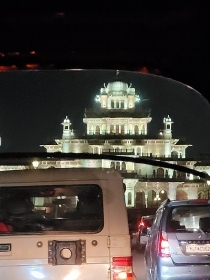
Early one morning in February 2025, our British Airways Boeing 777 jet began moving away from the oddly designed, apparently ‘eco-friendly’, Terminal Two at Bangalore’s International Airport. As the aeroplane taxied smoothly towards the runway, I watched the parched airport terrain and its assortment of buildings, some painted with red and white checkerboard patterns, slipping past. Then with a certain suddenness heralded by an increase in the noise of our jet engines, we accelerated along the runway. Soon, we became detached from the soil of India. As the aircraft rose higher and higher, random memories flashed through my mind. These included eating laal maas on a rooftop in Jaisalmer; a distraught restaurant owner in Jodhpur; a Dutch cemetery on the Coromandel Coast; hawkers wandering up and down a railway carriage in West Bengal; riding through Bangalore in a Jesus autorickshaw; blessing a newly married couple in Pondicherry; tasting homemade nolen gur in Murshidabad; attending an aarti on the Ganges; eating ravioli in Auroville; the ghost of Tipu Sultan; and much more. After flying over the west coast of India, all these experiences and a whole host of others that we had enjoyed during our 88 day stay in India (between November 2024 and February 2025) became, like the Indian coastline over which we flew, distant memories which I hope will remain etched permanently in my mind. In the pages of this book, I will revive these and a whole host of other reminiscences and explore them in detail. I want my readers to enjoy and understand what we experienced during our almost three month long stay in India.
June 16, 2025
The art of demolition in London’s Dering Street
THE ANNELY JUDA Fine Art Gallery is currently in London’s Dering Street, but it will soon be moving to a new location in Mayfair’s Hanover Square. To celebrate the gallery’s forthcoming departure from Dering Street, its final exhibition at that address is called “Demolition”. It is a collection of artworks created by Tadashi Kawamata (born 1953 in Japan). He lives and works in Paris (France).
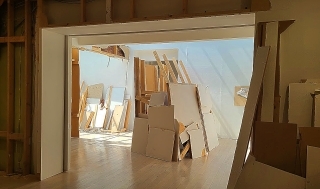
The name of the exhibition describes what the viewer will see: demolition. The artist has dismantled the gallery’s walls and panelling and used the fragments and debris from them to create a series of art works, which together make the gallery look like a building site. This might sound ridiculous, but the sculptural forms he created from the fragments of the gallery’s structure are both intriguing and exciting. It looks like someone had exploded a bomb within the gallery. However, certain elements remain untouched: cctv cameras, light switches, smoke detectors, and electrical sockets. Kawamata is well known for his site-specific creations. In addition to the sculptural ensembles that he created using the fabric of the gallery, there are several beautifully intricate three-dimensional maquettes of other projects the artist has planned or carried out.
Now, Annely Juda is a commercial gallery. I asked a member of its staff whether the amazing works that were on view in the gallery were for sale. He said that they are, and the artist will recreate the works for clients in their own spaces.
This amazingly unusual exhibition will continue until 5 July 2025.
June 15, 2025
A rose bush
June 14, 2025
A relic of a monastery in Dorset
A SMALL SIX-SIDED stone structure stands in the heart of the town of Sherborne in Dorset (UK). It is built with a yellowish stone in the mediaeval gothic style. Open to the elements on each of its six sides, its ceiling is a perfect example of gothic fan vaulting. Although it looks like a small kiosk or somewhere to shelter from the rain, it was not built as such.
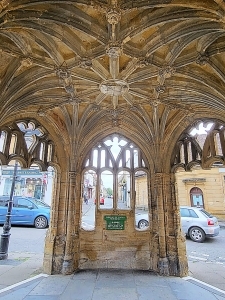
Sherborne is famous for its magnificent gothic abbey church, which stands a few yards from the structure mentioned above. Until 1539, the church was attached to a Benedictine monastery. The latter was dissolved by Henry VIII in 1539, when most of the monastic buildings were either destroyed or sold. Some of them now form part of the venerable private Sherborne School.
Like most monastic institutions, that at Sherborne had cloisters. The six-sided structure, now known as ‘The Conduit’ was originally built in the early 16th century as part of the cloisters, to serve as a washing place for the monks. It survived the demolition of the monastery, and now forms pat of the quaint urban landscape of central Sherborne.
June 13, 2025
Why are some post boxes in Britain not coloured with red paint?
PETER WILSON WAS born in the English county of Dorset in 1968. In the 2012 Olympic Games, he won a gold medal in a shooting event.
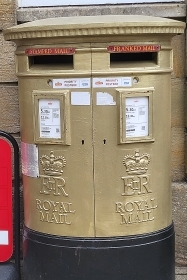
To celebrate Britons who won gold medals in the 2012 Olympic Games and Summer Paralympics, the Post Office painted several letter boxes with gold-coloured paint. It was originally planned to be a temporary measure, but as the public gave it much approval, the boxes have remained gold,
Peter Wilson’s Olympic achievement is celebrated by a gold letter box that stands in Sherborne, in Dorset. It can be found on Cheap Street. A plaque attached to it is there to remind people why the letter box is gold rather than the usual red.

